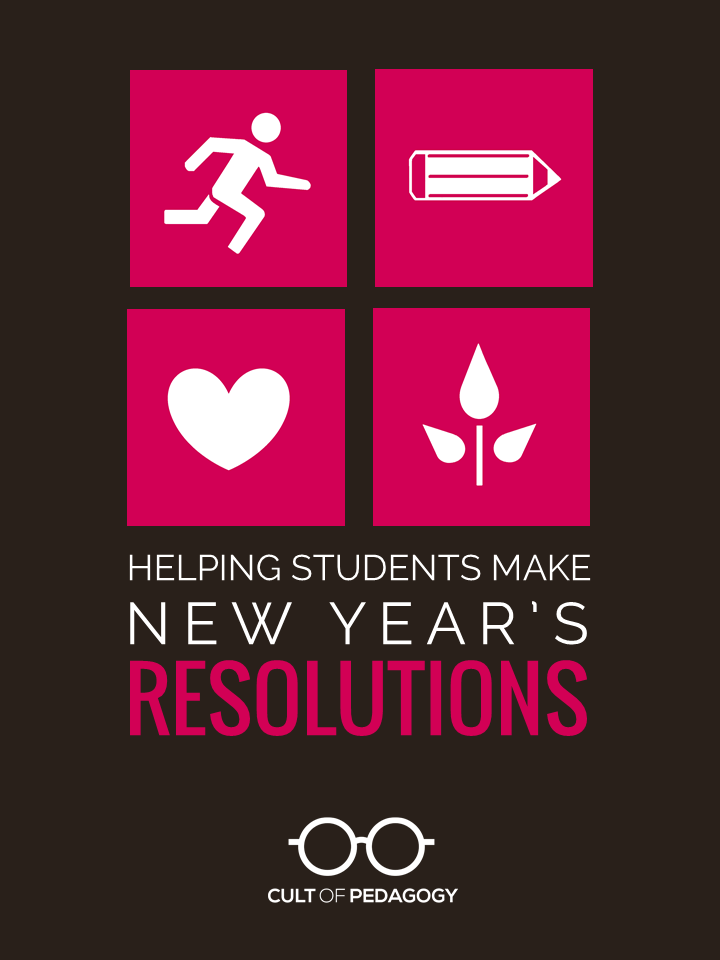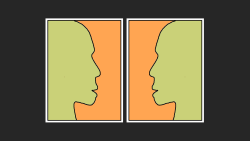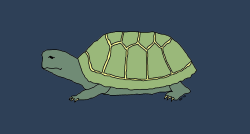
Just like the adults around them, our students may be looking at the new year as an opportunity for renewal, a time to assess their life and consider how they might want to improve it.
And we can help them. This week, since the topic of new year’s resolutions is likely to come up anyway, why not make a lesson out of it? Here’s a step-by-step plan you can use to help your students make the kinds of resolutions that could have a significant impact on their quality of life.
1. Get warmed up.
Ask students if any of them have made a new year’s resolution yet. Allow them to do a think-pair-share about this, then ask a few to share their resolutions with the class, if they have any. Also talk about your own, if you have one. This is just a casual conversation to get warmed up. If some students choose not to share, let them pass: There’s a chance they have some ideas, but they’d rather not announce them publicly.
2. Explore different kinds of resolutions.
One of the main goals of this lesson is to give students a better sense of the things in their lives they DO have control over. That’s an important message; one that can empower them to take ownership for their choices and start making big changes. And this message will be most effective if students are exposed to a broad range of possibilities, rather than limit themselves to whatever ideas they happen to come up with on their own.
So spend some time looking at the kinds of resolutions people make. You might brainstorm a list of possible resolutions on the board, then divide that list into categories. This would essentially be an inductive learning lesson. You could also have students do this in groups, or to save time, just prepare a list of example resolutions in advance.
The list could include categories and examples like these:
Health Resolutions: eat less junk food, exercise more, get better sleep
Academic Resolutions: set up a homework routine, keep school materials organized
Relationship Resolutions: be a better listener, stop gossiping, spend more time with family
Personal Growth Resolutions: learn a new hobby or skill, spend less time on devices
Once students have explored many possibilities, have them choose at least one resolution for the new year.
3. Explain how to turn a resolution into a goal.
One of the reasons some resolutions fail is because they aren’t specific or measurable. If a person resolves to “eat healthier,” that’s hard to measure and hard to track. With a broad resolution, it’s easy to fall into a gray area and eventually drop it altogether. So teach students how to take a vague resolution like “give my dog more attention” and turn it into a specific, measurable goal like “spend 10 minutes a day petting and playing with my dog.” Introduce students to the concept of SMART goals so they can craft a goal that meets all five criteria.
If a resolution is something more complex and long-term, like “learn how to cook,” have students think about what success with that resolution might look like: Maybe someone who knows how to cook can make a certain number of meals easily, so have the student decide what that number is and set a deadline for learning that number of meals. Or better yet, have them create a list of specific things they want to learn how to cook; this can serve as a checklist for the year.
4. Show students how to track their goals.
Explain to students that people generally have a greater chance of meeting their goals if they keep track of their progress in some way. Then show them how to do it.
Because students will have different kinds of goals, they will need different approaches to this tracking. Some will have the kind that require daily changes, like flossing every day or spending time each day with a pet. For a goal like that, they could use a daily record like this one, where they record “scores” they define themselves.

For a more complex, long-term goal, it may be more appropriate to set milestones that lead up to the bigger, broader goal. A milestone tracker like this one could help facilitate that:

5. Later, provide time to reflect.
Plan class time later on for students to do some written reflection on the progress they have made. Have them consider how well their plan is going, what factors may be getting in their way, or how the new changes are impacting their quality of life. The first time might be a week after goals are set, followed by two more check-ins spaced further apart. During these reflection times, share how your own goals are going, and talk to students about how sometimes we end up changing our goals based on what we learn about ourselves over time.
Suggestions for Success
Here are a few suggestions to give this lesson the greatest impact:
Make it ungraded. This is the kind of activity that has value beyond academics or grades, and students may be more intrinsically motivated to complete it if it is not tied to a grade. On the other hand, if you believe students will not do it without some kind of school credit, consider just assigning points for completion, rather than evaluating students’ work on it. If you have a student who doesn’t take it seriously, chalk it up to a maturity issue; at least they have been exposed to the ideas.
Allow time for discussion. Although students have likely heard about or made new year’s resolutions before, this may be the first time they have been given a structured opportunity to think it through. And it’s highly likely they have only ever heard people in their immediate circle talk about their resolutions; being exposed to the ideas of people they don’t normally spend time with can broaden their ideas about where they might want to grow.
Respect student privacy. Some of your students may be wrestling with serious issues, problems they may not want to discuss with anyone, including you. From the start of this lesson, let students know that if they would prefer to keep their resolutions private, you will respect that. If you need to give points for participation, you might have students give you a very brief peek at part of their plan, just so you can see that they completed it.
Don’t use this as a sub plan. In order for students to take this assignment seriously, they need to be with someone they trust, so unless you know they will have a sub with whom they already have a great relationship, hold off on this project until a time when you will be with your students.
Want this lesson ready-made?
I have put together a New Year’s Resolutions lesson based on these concepts, including printable goal-tracking sheets and reflection forms, ideal for use in grades 6-12, but also appropriate for grades 4 and 5. The lesson also includes access to the forms in Google Drive, for paperless classrooms.
To take a closer look at the lesson, click the image below:
Join the Cult of Pedagogy mailing list and get weekly tips, tools, and inspiration — in quick, bite-sized packages — all geared toward making your teaching more effective and fun. To thank you, you’ll get a free copy of the e-booklet, 20 Ways to Cut Your Grading Time in Half, which has helped thousands of teachers spend less time grading!






I’m surprised you didn’t reference SMART Goals. I have a short PowerPoint that i use that includes this sentence prompt: I will/want (specific goal) to achieve (measurement—must have a Number) by doing (action plan) by (date: timeline). However, I love the idea of teaching students to create their own graphic organizer to create a visual, frequent reminder of their own progress.
Yep, SMART goals would be a great fit here. Thanks for adding that! Here’s an overview for anyone new to this structure: https://en.wikipedia.org/wiki/SMART_criteria
Hi Jennifer, thank you very much for the great ideas you provide for me to be able to work with my students. As School Adjustment Counselor I teach lessons about social skills. This is wonderful, because I started my lessons about “New Year Resolutions”, so la informacion fue bien util y mis estudiantes (K-5) participaron y estaban bien entusiasmados. Gracias un monton, como decimos los puertorriquenos. Te lo agradezco y te admire mucho.
This is a great help. Thanks for sharing!
thank u
Love it! Will use it on Monday Jan 16th when my students return!! Thanks so much!!
Might you have any suggestions (or resources to point me to) for ways to tailor this for 2nd graders?
Hi Maura,
I taught 1st grade for many years, and I think a lot of the ideas in the post could easily be adapted for 2nd graders. Just make sure you know exactly what it is you most want your kids to be able to do in the end. Here’s where I might take this, just off the top of my head: I’m thinking I’d really want the kids to understand the meaning of a resolution, so they can apply resolution-making to all aspects of their lives, not just in the context of a new year’s resolution. I’d plan some sort of vocabulary lesson that would help them understand the connections among “resolution” and” resolve”(to make a decision or to plan a course of action) and “solution” (solve). In the end I want kids to be able identify a problem they’ve been wanting to fix for awhile and create a course of action as to how they will solve it. With this understanding, I could bring up the idea that a lot of people see the new year as a fresh start, a time to work on a problem and resolve it. You can pick out parts of the post that you want to apply in your lesson. Example: identify a problem, plan a way to resolve it, create a way to track progress, plan times of reflection. Provide some modeling and break the lesson into manageable parts (perhaps over the course of a few days). In the end, kids will show understanding that making resolutions is about problem solving that can be done at any time, in any area of their lives. Hope this gives you some ideas to latch onto!
Love this! I think it is so important for educators and parents to help young people build healthy habits early on in their lives so it becomes second nature in adulthood. Along with SMART goals, I recommend pairing this with habitwise.org. It’s a free, online program that teaches students to build habits using a principle from psychology called the habit loop.